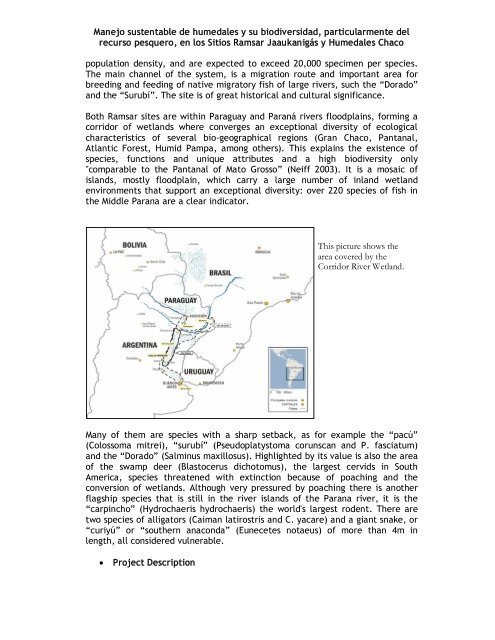Argentina - Ramsar Convention on Wetlands
Argentina - Ramsar Convention on Wetlands
Argentina - Ramsar Convention on Wetlands
Create successful ePaper yourself
Turn your PDF publications into a flip-book with our unique Google optimized e-Paper software.
Manejo sustentable de humedales y su biodiversidad, particularmente del<br />
recurso pesquero, en los Sitios <str<strong>on</strong>g>Ramsar</str<strong>on</strong>g> Jaaukanigás y Humedales Chaco<br />
populati<strong>on</strong> density, and are expected to exceed 20,000 specimen per species.<br />
The main channel of the system, is a migrati<strong>on</strong> route and important area for<br />
breeding and feeding of native migratory fish of large rivers, such the “Dorado”<br />
and the “Surubí”. The site is of great historical and cultural significance.<br />
Both <str<strong>on</strong>g>Ramsar</str<strong>on</strong>g> sites are within Paraguay and Paraná rivers floodplains, forming a<br />
corridor of wetlands where c<strong>on</strong>verges an excepti<strong>on</strong>al diversity of ecological<br />
characteristics of several bio‐geographical regi<strong>on</strong>s (Gran Chaco, Pantanal,<br />
Atlantic Forest, Humid Pampa, am<strong>on</strong>g others). This explains the existence of<br />
species, functi<strong>on</strong>s and unique attributes and a high biodiversity <strong>on</strong>ly<br />
"comparable to the Pantanal of Mato Grosso” (Neiff 2003). It is a mosaic of<br />
islands, mostly floodplain, which carry a large number of inland wetland<br />
envir<strong>on</strong>ments that support an excepti<strong>on</strong>al diversity: over 220 species of fish in<br />
the Middle Parana are a clear indicator.<br />
This picture shows the<br />
area covered by the<br />
Corridor River Wetland.<br />
Many of them are species with a sharp setback, as for example the “pacú”<br />
(Colossoma mitrei), “surubí” (Pseudoplatystoma corunscan and P. fasciatum)<br />
and the “Dorado” (Salminus maxillosus). Highlighted by its value is also the area<br />
of the swamp deer (Blastocerus dichotomus), the largest cervids in South<br />
America, species threatened with extincti<strong>on</strong> because of poaching and the<br />
c<strong>on</strong>versi<strong>on</strong> of wetlands. Although very pressured by poaching there is another<br />
flagship species that is still in the river islands of the Parana river, it is the<br />
“carpincho” (Hydrochaeris hydrochaeris) the world's largest rodent. There are<br />
two species of alligators (Caiman latirostris and C. yacare) and a giant snake, or<br />
“curiyú” or “southern anac<strong>on</strong>da” (Eunecetes notaeus) of more than 4m in<br />
length, all c<strong>on</strong>sidered vulnerable.<br />
· Project Descripti<strong>on</strong>
















